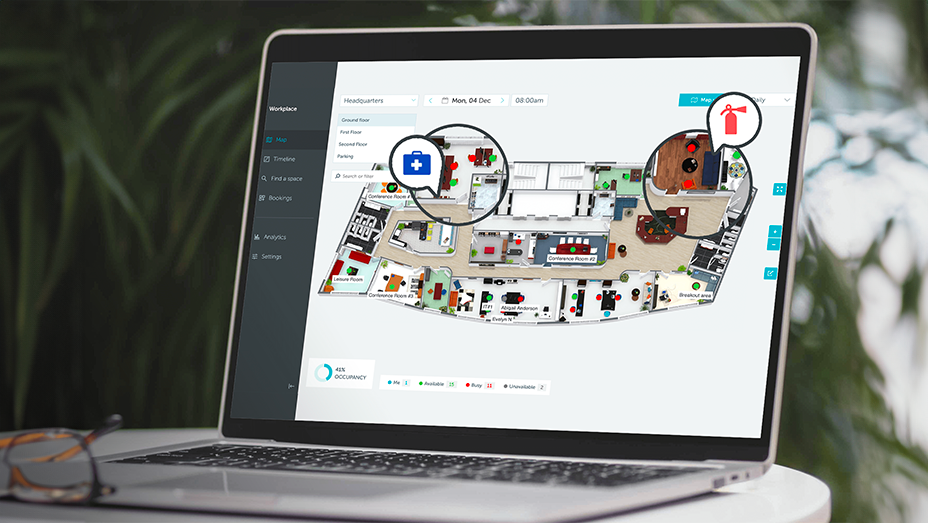Safety culture in the workplace is no longer just a buzzword passed around in meetings or a box to tick on compliance forms, but the heartbeat of every successful business. Today, a solid safety culture is essential to fostering trust, accountability and productivity in your work environment.
But how did we get here and what can we do if we feel our protocols aren't ensuring enough safety in the workplace?
TL;DR:
- A strong safety culture not only ensures the well-being of employees, but also contributes to higher productivity, morale and overall success.
- By cultivating a safety culture at all levels, involving employees in safety procedures, ensuring transparency for all, implementing continuous improvement procedures and involving key stakeholders in creating this culture, organizations can significantly improve their overall safety performance. Technology is also an important factor in promoting a safety culture.
- To check how safe your workplace is, keep an eye on industry standards and best practices. Get employees in on it too – their input is key!
Safety Culture in the Workplace: Not a “Nice to Have” Anymore
Gone are the days when safety was merely an afterthought in the workplace, taking a backseat to productivity and profit. Today, safety culture has evolved from a “nice to have” to an absolute necessity for every organization.
Just like company culture shapes a company's identity, workplace culture sets the tone for how employees feel when they come into the office, how productive they are as a result, and how much safety is prioritized and integrated into daily operations.
The Importance of Establishing a Strong Safety Culture
Organizations need to recognize that investing in safety isn't just about workplace compliance, but about protecting their most valuable asset: their people. Having safety as a culture fosters trust, communication and accountability among team members at all levels.
By emphasizing safety as a core value, companies create an environment where employees feel empowered to speak up without fear of retaliation. This open dialog encourages continuous improvement and drives innovation for safer work practices.
But beyond policies and procedures, it's about cultivating a mindset where safety is embedded in every aspect of work life. When everyone has internalized the importance of safety in the workplace, it becomes an integral part of daily work and not just an afterthought.

Workplace Safety Culture in Numbers
- Approximately 83% of employees have encountered emergencies at work, ranging from severe weather to workplace violence and public health crises.
- 81% of employees consider their physical safety extremely important, but only 58% think their employer shares the same view.
- The majority of employees say that they are more satisfied (82%) and feel more productive (79%) in workplaces with a strong safety culture.
- Almost all employees (97%) believe feeling safe is crucial when deciding where to work.
- For every $1 invested in workplace safety, organizations can expect a return of $4 to $6 in cost savings.
- Companies with engaged employees achieve a 70% reduction in safety incidents.
Characteristics of a Robust Safety Culture in the Workplace
A robust safety culture in the workplace is characterized by a deep-rooted commitment to employee well-being. This is what it looks like:
Safety as the Top Priority
At the core of a solid safety culture is the fundamental belief that safety is not just a box to be ticked, but the top priority. This sets the tone for all activities in a company. From management decisions to employee actions, prioritizing safety sends a clear message that everyone's health and well-being is non-negotiable.
This proactive approach can foster trust among employees and boost morale, leading to higher productivity and overall satisfaction within the organization.
Accountability at All Levels
Accountability at all levels is about everyone taking responsibility for creating a safe environment. Leaders need to lead by example and show that safety is a top priority, and employees should feel that they can speak up if they notice unsafe practices or conditions.
Encouraging open communication and active participation creates a sense of shared responsibility for maintaining a safe work environment. This promotes collective commitment to safety and ensures that each individual understands their role in maintaining it.
Employee Influence on Safety Procedures
Employees play a crucial role in shaping safety procedures in the workplace. Their input and feedback, as well as their collaborative approach, can provide valuable insight into potential hazards and areas for improvement and boost overall morale and commitment.
Plus, employees who are actively involved in developing a safety culture at work are more likely to follow them consistently. When they understand the reasons for certain safety protocols and have been involved in their development, they are more likely to adhere to these standards.
Visibility for Everyone
Another innovative approach to enhance safety is by implementing visibility features, such as enabling emergency roles in the office. This means ensuring there are always people present who are trained in critical areas like Fire Safety or First Aid, and that everyone knows who they are.
Imagine a scenario where, upon booking a desk, a special icon appears next to the reservation on the floor map, signaling to everyone in the office that this person is equipped to deal with emergencies. This level of visibility not only reinforces a commitment to safety but also provides reassurance to the entire team.

The ability to easily identify trained personnel through intuitive visual cues promotes a safer work environment and encourages a collective responsibility for well-being in the workplace.
Continuous Improvement Practices
Continuous improvement is the backbone of a strong safety culture in the workplace. By regularly reviewing and updating safety procedures, companies can adapt to changing circumstances and prevent accidents before they happen.
Employee feedback is important to identify opportunities for improvement. It encourages a sense of ownership among employees, ensures that they are more committed to maintaining a safe workplace and can lead to practical solutions that address the specific safety concerns of individual departments or teams.
Regular training on safety protocols keeps employees up to date with best practices and regulations. These educational initiatives provide employees with the knowledge and skills they need to respond effectively to emergencies so that everyone is alert and prepared at all times.
And then there is the use of innovative safety technologies. Tools such as digital platforms for reporting incidents or monitoring hazards increase the efficiency and effectiveness of managing all kinds of safety risks in the workplace.
Key Participants in Creating a Safety Culture
Creating a safe workplace environment requires the collaboration of key stakeholders at all levels of the organization.
- Management plays a critical role by setting the tone for safety, providing resources and leading by example.
- Employees are key stakeholders as they implement safety procedures on a daily basis and provide valuable feedback on potential improvements.
- Health and safety experts contribute their expertise to ensure compliance and recommend best practices to improve safety in the workplace.
- Human Resources supports us by integrating safety into training programs, policies and hiring processes to promote a culture where safety is a high priority for employees.
- Frontline supervisors also play an important role in encouraging safe behavior in their teams through clear communication, coaching and reinforcement of safety protocols.
- Facility managers develop and maintain the physical environment that meets safety standards and lead safety initiatives to ensure compliance.
Implementing an Effective Safety Culture in the Workplace: The 4 E’s Framework
To create a robust safety culture in the workplace, companies can implement the 4 E’s framework: Engineer, Educate, Empower, and Enforce.
Engineer
Managers and leaders play a crucial role in creating safety in the work environment. They must champion and monitor the development and implementation of safety protocols and procedures to ensure a safe work environment for all employees.
They are able to post appropriate safety information and equipment throughout the building, collaborate with other key stakeholders to drive continuous improvement in safety practices, and optimize current processes to improve overall safety standards in the workplace.
Educate
Safety training plays a crucial role in ensuring that all employees are equipped with the knowledge and skills to deal effectively with potential hazards. This proactive approach not only raises employee awareness, but also promotes a sense of responsibility for creating a safe work environment for all.
In addition, continuous training ensures that employees are always up to date with the latest safety regulations and best practices. This enables them to identify risks before anything happens, report incidents, and take appropriate action immediately.

Empower
Empowering employees to take responsibility for safety is an important aspect of promoting a strong safety culture in the workplace and creating a collaborative environment. Empowerment leads to a stronger commitment and willingness to see safety as an integral part of the company's daily work.
Providing training and resources equips employees with the knowledge and tools they need to make informed decisions for their safety and that of their colleagues. And encouraging open channels of communication allows for feedback on existing safety protocols and therefore continuous improvement.
Enforce
Enforcing safety practices in the workplace involves setting clear expectations, providing adequate resources, and holding everyone accountable for their actions. It should go without saying that enforcement should be fair and consistent at all levels of the organization.
Managers play a key role in enforcing safety measures by setting a good example for their teams and repeatedly emphasizing the importance of following procedures. Training, regular reminders, and rewards for employees who maintain a positive safety culture can also help to reinforce these standards.
How Technology Is Helping Improve Safety Culture in the Workplace
Modern technology is revolutionizing safety in the workplace, going beyond tracking entries and exits with advanced visitor management systems. The use of technology streamlines safety procedures, improves emergency response times and reduces potential risks.
For example, office capacity management tools now play a crucial role in maintaining optimal space occupancy and providing a safer work environment. And with features such as office emergency roles, employees can easily identify trained personnel for crucial situations, increasing both safety and a sense of security.
Embracing these technological advances lays the foundation for a proactive approach to workplace safety and fosters a culture where employees feel both empowered and protected at all times.
The Importance of Addressing Workplace Safety for Remote Employees
With hybrid and remote work becoming increasingly popular, it is important to ensure the safety of employees. Even if they are not physically present in the office, their well-being is a top priority. Remote workers face particular challenges that can affect their safety and health.
In particular, employers need to establish clear guidelines for ergonomics, mental health, and emergency procedures for remote workers. Virtual check-ins, safety training via video conferencing, and providing resources for ergonomic set-up of home offices are important steps to create a safe work environment for remote employees.
By proactively addressing workplace safety for remote employees, organizations demonstrate their commitment to the well-being of their employees, regardless of their location.
How to Evaluate Your Workplace Safety Culture?
To evaluate the culture of safety in the workplace, start by observing daily operations. Are safety protocols consistently followed, starting with the front desk? Do employees prioritize safety in their tasks?
Conduct regular assessments and surveys to get feedback from team members. Do they know the safety procedures and feel empowered to address potential hazards?
Review incident and near miss reports to identify trends or areas for improvement. Is there a pattern of accidents that could be prevented with better training or resources?
Maintain open communication with employees at all levels to promote transparency on safety issues. Do employees feel safe reporting issues without fear of retaliation?
Review the effectiveness of safety training programs and initiatives using metrics such as accident rates and compliance rates. Are these efforts leading to a safer work environment for everyone involved?
Summing It Up
Remember, safety should never be just another box to check off, it should become part of your company’s DNA. A strong safety culture not only protects lives, but also increases the resilience and sustainability of your business in the long run.












